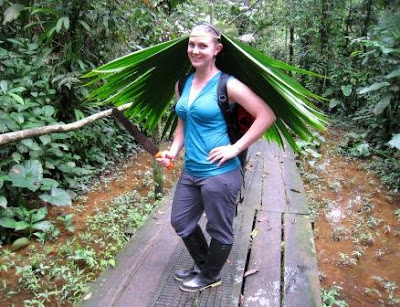 |
| Cooking Tents below Nevado Tocllaraju |
In the U.S., this kind of load would be impossible because you have to pack in and out all your supplies on your back. In most climbing areas, pack animals are not allowed or are mighty expensive. Here, we paid US$30 for 3 burros, a small horse, and a man to drive them to our base camp – home for the next six days.
Carrying only water and cameras up the trail to base camp, accompanied by various burros, cows, sheep, horses and dogs, was an easy and beautiful 3-hour walk.
We both hardly slept that night for whatever unknown reason and decided at about 3am to simply get an earlier start on our climb of Ishinca, a mountain up the valley a good ways that reaches about 18,250 feet. Our first ten steps or so outside the cooking tent were in the wrong direction. Juan, who has been a porter for over 30 years and has climbed every peak in our climbing book at least 10 times (15 times for the popular ones) decided to show us the way and ultimately led us to the toe of the glacier, about 2,000 vertical feet from base camp.
I found myself strenuously power-walking in my rented plastic boots, audibly huffing and puffing to keep up with a shockingly agile 53-year-old man and a caffeinated Michael. Fortunately, we made great time. Unfortunately, I was beat by the time we got to where the actual route begins – everything so far had been only the approach.
 |
| Sunrise (with the moon) on Ranralpaca, on our approach to Nevado Ishinca |
It didn’t help that, when the sun started beating down on us, Michael realized he forgot his sunglasses at base camp. Rather than risk snow-blindness or turn around, he chose to put on his balaclava (like a heavy sky mask with an opening just for your eyes) – backwards, covering his entire face and eyes. Thus, he was half-blind, exceedingly hot, had difficulty breathing, and looked ridiculous.
It looked like a safe climb to the summit without having to cross or get near any crevasses, so we dropped all our technical gear except ice axes to lighten the load to the top. A small outcropping of rock just above us gave us a seemingly inconsequential choice of which way to go around it. We chose right. We chose wrong. The right side, unlike the left, had one large and deep crevasse between us and the safe slopes to the top. Michael found, and crossed, what was, in reality, a wide and safe ice bridge but, to me, was the bridge of death. So I sat down and ate snow, content to watch Michael trudge his way to the summit and back down to our abandoned gear. The scenery was absolutely stunning, but we took little notice of it in our misery and exhaustion.
During our tedious descent to base camp, my body started freaking out from some combination of altitude sickness and pure exhaustion. I was wheezing and coughing uncontrollably and breathing only in panicky, short breathes. Michael followed my slow and staggering steps because I was afraid I might collapse. I made it down on my own steam to base camp, had hot tea, a warm meal, and then lay down in the tent for hours, with Michael next to me, watching closely. We both were concerned I had HAPE – High Altitude Pulmonary Edema – when fluid gets into your lungs and can cause serious, long-term damage. But, other than my respiratory problems, I showed no other symptoms. Brilliantly, Michael gave me his headphones so I could listen to my Kindle read to me (I <3 my Kindle!) and, with my mind and fear of HAPE distracted, my body relaxed and my breathing got better and better. By dinner, our crisis was averted and we knew it was mostly exhaustion-induced.
 |
| The view from our Tocllaraju high camp a few hours before sunset. |
 |
| A self-portrait of Michael, high above the Ishinca Valley |
 |
| Star trails over our Tocllaraju high camp just hours before a storm rolled in. |
It was still snowing when we finally emerged from the tent around 7:30am, cold, tired and miserable. Happy Anniversary to us!! All our gear outside was frozen solid, making it difficult to pack up and tie our frozen shoelaces. Then we heard a loud rumble and watched a huge avalanche flow down the face of the mountain, not far from the route... confirming that we made the right decision to stay off of it.
 |
| Taylor descending from the Tocllaraju storm with Ranrapalca, a 20,000 ft peak, in the distance. |
In retrospect, perhaps this whole trip was a necessary blunder – a reality check on our overly-ambitious itinerary for the next few weeks. We learned a lot about climbing in these mountains or, as Michael so gracefully put it: “how f*ing cold it is to sleep at 17,000 feet.” Most importantly, we spent 6 days above 14,000 feet, which should help us acclimatize for the long run. Those are about all of the up-sides I can think of.
However, the warm sun is shining again in the mountains and Michael and I have adjusted our plans so that our next adventures should be far more enjoyable.















